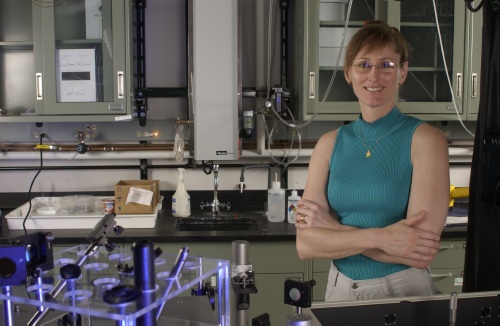
Professor Heather C. Allen attended Saddleback College from 1989-1992, completing much of her undergraduate science and general education coursework before transferring to the University of California, Irvine in 1992. After her second year at Saddleback, she focused on the sciences, targeting chemistry as her major, winning a Saddleback College Science Scholarship Award to continue advancement toward her chemistry degree. She received her B.S. degree in Chemistry in 1993, and Ph.D. in Physical Chemistry in 1997 at the University of California Irvine working with Nobel Laureate F. S. Rowland, and Professors D. Blake, J. Hemminger, and B. Finlayson-Pitts. She continued her postdoctoral studies in 1997 at the University of Oregon advised by Professor G. L. Richmond. Following the Saddleback Science Scholarship, as a student and postdoctoral researcher, she was also recognized with other scholarships and fellowships: Fannie and John Hertz Fellowship, EPA, NSF Traineeship, and a NOAA Post-Doctoral Fellowship in Climate and Global Change.
She began her Professorial career at Ohio State in 2000, and has since been recognized for many research accomplishments: Research Innovation Award from Research Corp., NSF CAREER Award, Beckman Young Investigator Award, Alfred P. Sloan Research Fellow Award, Camille Dreyfus Teacher-Scholar Award, Fellow of the American Association for the Advancement of Science (AAAS), Ohio State Distinguished Scholar Award, Alexander von Humboldt Research Award from Germany, and the Tohoku Forum for Creativity Award from Japan. She is currently the Dow Professor of Chemistry (as of 2019).
In addition, Dr. Allen has been recognized for several mentoring awards over the years including the Ohio State Office of Minority Affairs Mentor Award, an Empowered Woman Award from the City of Columbus, and the American Chemical Society National Award for Encouraging Women into Careers in the Chemical Sciences.
She is a Full Professor in the Department of Chemistry and Biochemistry, and in the Department of Pathology. Her research specialization is in molecular organization, ion pairing, and hydration at aqueous interfaces.
Research Overview
Molecular Organization at Interfaces: Atmospheric Aerosols – Air/Water Interfaces, Geochemical Interfaces, Biophysics of Lung Surfactant and Model Biomembranes, and Nonlinear-Optical Spectroscopy and Microscopy
Research in the Allen group encompasses the characterization of fundamental interfacial phenomena. Aqueous surfaces are of particular interest with emphasis on understanding surface structure. Investigations of molecular organization and orientation, and chemical reaction mechanisms at gas – liquid, gas – solid, and liquid – solid interfaces are of interest. Laboratory experiments are designed to further understand organization of solvated ions and molecules such as water, lipids, and fatty acids at surfaces and interfaces of biological and environmental relevance.
Cell membranes, atmospheric aerosols, cloud microdroplets, and geochemical systems are interfacial systems that can be studied using vibrational spectroscopic methods. The Allen group utilizes and designs optical spectroscopic instruments to this end. The applications to this work drive the fundamental investigations. For example, in the atmosphere heterogeneous chemistry of liquid aerosols plays a critical role in thunderstorm and lightening production. In biology, cell membranes are dynamic barriers and gateways to the cell interior as is skin on a more macroscopic level. The lung lining is a uniquely dynamic barrier that is critical for oxygen and carbon dioxide transport to and from biological tissues. In geochemistry, water-solvated ions and ion pairs and minerals interact at surfaces and the interaction strength is key to the mechanisms of adsorption and transport. Cancer margin detection (collaborators Coe, Magliery, Hitchcock, Martin, Povoski) is focused on methodology and technology development.
To understand the molecular-level details of an interface, state-of-the-art nonlinear optical technologies that utilize ultra-fast femto and picosecond laser pulses are necessary. Hence, surface vibrational sum frequency generation (VSFG) spectroscopy, broadband and scanning technologies, are used to elucidate interfacial chemistry. VSFG is inherently interface-selective and provides molecular-level interfacial information that includes relative orientation and structure of the surface species, i.e. the surface signature. An array of analytical optical spectroscopic and interfacial methods is incorporated to fully understand the heterogeneous chemical processes at an interface, for example, polarized Raman and infrared spectroscopies and microscopies, broadband VSFG, specular reflection infrared spectroscopy, and Brewster angle microscopy for biological and environmental applications.
Previous Allen group members have positions in industry, national laboratories, and academia: PPG Technologies in Pittsburgh, KLA Tencor; Batelle Corporation (Analytical and Aerosol Divisions); Chemical Abstracts Service; Canadian Synchotron Facility; Spartan Chemical; OSU Surface Science Facility; Syngenta, Switzerland; Pacific Northwest National Laboratory; professor positions at Bowdoin College-Maine, Ohio Wesleyan University in Ohio, and Herbei University in Baoding, China.
